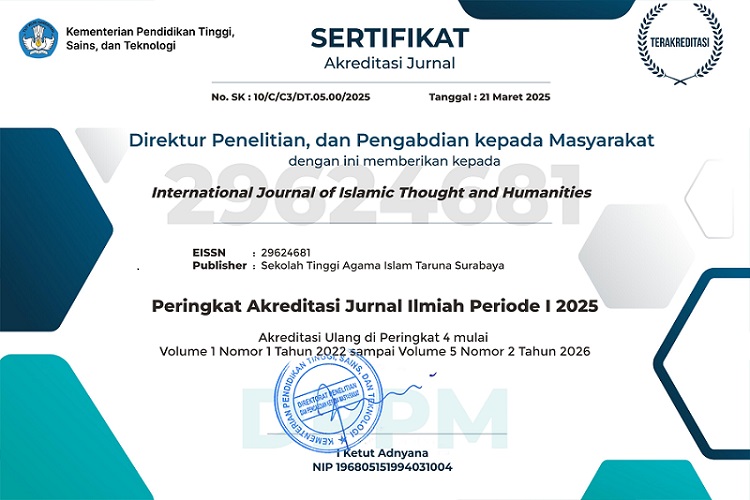Descriptive Study of the Nabawiyah Sirah by Ibn Ishaq and Ibn Hisham
DOI:
https://doi.org/10.54298/ijith.v1i2.28Keywords:
Sirah Nabawiyah, History, Ibn Ishaq, Ibn HishamAbstract
The position of sirah or the study of the history of the prophet Muhammad SAW has an important position in the Islamic religious tradition where it ranks second after the study of hadith or sunnah. Thus, this article aims to describe how the study of the nabawiyah sirah was carried out by the two main retainers of its writing, especially seeing how the process and the relationship between these two sirah works from a historical perspective. This article itself was written with a qualitative descriptive approach supported by data collection methods in the form of literature study. From the results of the review, it is known that Ibn Ishaq's sirah is the first work that is able to systematically review the life story of the prophet, although there are still many shortcomings and finally it was perfected by Ibn Hisham with his sirah work. Both Ibn Ishaq and Ibn Hisham, both have important contributions in writing the book Sirah Nabawiyah. Ibn Ishaq with the quality of his book narration is strong enough to make his work an important reference in the study of the nabawiyah sirah.
Downloads
References
Abdullah, Y. A. (2004). Historiografi Islam: Dari Klasik Hingga Modern. Jakarta: Rajawali Pers.
Abror, M. (2021, Desember 8). Kontribusi Ibnu Ishaq dan Ibnu Hisyam dalam Penulisan Sirah Nabawiyah. Dipetik September 3, 2022, dari https://islam.nu.or.id/sirahnabawiyah/kontribusi-ibnu-ishaq-dan-ibnuhisyam-dalam-penulisan-sirah-nabawiyah2qayg
Al-Buthy, M. S. (1999). Sirah Nabawiyah: Analisis Ilmiah Manhajiah Sejarah Pergerakan Islam di Masa RasuIullah saw. (A. R. Tamhid, Penerj.) Jakarta: Rabbani Press.
Al-Bhuty, S. R. (2010). FIKIH SIRAH: Hikmah Tersirat dalam Lintas Sejarah Hidup Rasulullah SAW. (F. S. Nur, Penerj.) Jakarta: Hikmah.
Anwar. (2007). Sirah Nabawiyah. Jakarta: Diktat Pendidikan Agama Islam.
Bastari, A. (2011). Strategi Perang Badar Menurut Ibnu Hisyam dan At-Thabari. Jurnal TAPIs: Teropong Aspirasi Politik Islam, 7(13), 7893.
Deraman, F., & Yusof, A. S. (2010). Muhammad bin Ishaq Menurut Perspektif Nuqqad dan Muhaddithin. Jurnal Islam dan Masyarakat Kontemporer, 3(3).
Hartimah, T. (2002). Sirah Nabawiyah. Jurnal at-Turas, 7(1), 65-78.
Hasbillah, A. U. (2012). Sirah Nabawiyah dan Demitologisasi Kehidupan Nabi. Journal of Qur'an and Hadits, 1(2), 251-261.
Hisyam, A. M. (1994). Sirah Nabawiyah. (S. M. Allaham, Penerj.) Beirut: Danjil Fikr.
Pratama, F. S. (2022). ANALISIS KOMPARATIF HISTORIOGRAFI SIRAH NABAWIYAH KARYA IBNU ISHAQ DAN IBNU HISYAM. Majalah Ilmiah Tabuah: Ta’limat, Budaya, Agama dan Humaniora, 26(1), 21-29. Diambil kembali dari Majalah Ilmiah Tabuah: Ta’limat, Budaya, Agama dan Humaniora : https://rjfahuinib.org/indek.php/tabuah
Prayogi, A. (2022). Ruang Lingkup Filsafat Sejarah dalam Kajian Sejarah. SINDANG: Jurnal Pendidikan Sejarah Dan Kajian Sejarah, 4(1), 1-10.
Prayogi, A. (2022). Karakteristik Wacana Keilmuan Islam: Suatu Telaah Komparatif. KOLONI, 1(2), 73-82.
Prayogi, A., & Anggraeni, D. (2022). Perkembangan Tema Dalam Historiografi Islam: Suatu Telaah. Studi Multidisipliner: Jurnal Kajian Keislaman, 9(1), 33-56.
Thohir, A. (2012). Historiografi Islam: Bio-Biografi dan Perkembangan Mazhab Fikih dan Tasawuf. Miqot: Jurnal Ilmu-ilmu Keislaman, 36(2), 427-451.
Wilaela. (2016). Sejarah Islam Klasik. Pekanbaru: Fakultas Ushuluddin UIN Syarif Kasim Riau.
Yatim, B. (1997). Historiografi Islam. Jakarta: Logos Wacana Ilmu.
Downloads
Published
How to Cite
Issue
Section
License
Copyright (c) 2022 Arditya Prayogi, ‘Alamul Yaqin, M. Zulvi Romzul Huda Fuadi

This work is licensed under a Creative Commons Attribution-ShareAlike 4.0 International License.
Authors who publish with this journal agree to the following terms:
- Authors retain copyright and grant the journal right of first publication with the work simultaneously licensed under a Creative Commons Attribution-ShareAlike 4.0 that allows others to share the work with an acknowledgement of the work's authorship and initial publication in this journal.
- Authors are able to enter into separate, additional contractual arrangements for the non-exclusive distribution of the journal's published version of the work (e.g., post it to an institutional repository or publish it in a book), with an acknowledgement of its initial publication in this journal.
- Authors are permitted and encouraged to post their work online (e.g., in institutional repositories or on their website) prior to and during the submission process, as it can lead to productive exchanges, as well as earlier and greater citation of published work (See The Effect of Open Access).


















